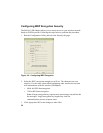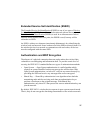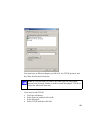
37
Extended Service Set Identification (ESSID)
The Extended Service Set Identification (ESSID) is one of two types of Service
Set Identification (SSID). In an ad-hoc wireless network with no access points, the
Basic Service Set Identification
(BSSID) is used. In an infrastructure wireless
network which includes an access point, the ESSID is used, but may still be
referred to as SSID.
An SSID is a thirty-two character (maximum) alphanumeric key identifying the
wireless local area network. Some vendors refer to the SSID as network name. For
the wireless devices in a network to communicate with each other, all devices
must be configured with the same SSID.
Authentication and WEP Encryption
The absence of a physical connection between nodes makes the wireless links
vulnerable to eavesdropping and information theft. To provide certain level of
security, the IEEE 802.11 standard defines two types of authentication methods:
• Open System — Open System authentication is a null algorithm which
requires an system identifier but does not encrypt the wireless data. With
Open System authentication, a wireless PC can join any network merely by
providing the SSID and receive any messages that are not encrypted.
• Shared Key — Shared Key authentication is an algorithm where both the
transmitting node and the receiving node share an authentication key to
perform a checksum on the original message. With Shared Key
authentication, only those PCs that possess the correct authentication key can
join the network.
By default, IEEE 802.11 wireless devices operate in open system network mode.
That is, they do not encrypt the data being transmitted over the wireless network.


















